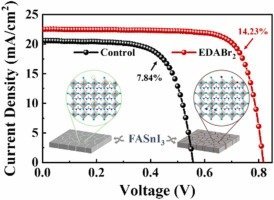Dual-site passivation of tin-related defects enabling efficient lead-free tin perovskite solar cells
Yiting Jiang, Zhengli Lu, Shengli Zou, Huagui Lai, Zhihao Zhang, Jincheng Luo, Yuanfang Huang, Rui He, Jialun Jin, Zongjin Yi, Yi Luo, Wenwu Wang, Changlei Wang, Xia Hao, Cong Chen, Xin Wang, Ye Wang, Shengqiang Ren, Tingting Shi, Fan Fu, Dewei Zhao,
Nano Energy, Volume 103, Part A, 2022, 107818, ISSN 2211-2855,
https://doi.org/10.1016/j.nanoen.2022.107818.
Ethylenediammonium halide salts (i.e., EDAI2 and EDABr2) are good candidates to passivate Sn oxidation and deep traps in lead-free Sn-based Perovskite.
The group of Dewei Zhao at the Institute of New Energy and Low-Carbon Technology in Sichuan university recently discovered that EDABr2-modified perovskite devices could achieve 14.23% efficiency and retain 95% of the performance after 110 hours at operating conditions.
By performing transient photocurrent (TPC) and transient photovoltage (TPV) measurements with the Paios tool from Fluxim AG, they observed a TPC lifetime improvement from 1.29 us to 0.74 us and TPV lifetime from 5.9 us to 37.83 us, confirming the improved charge transport and charge recombination lifetimes.

